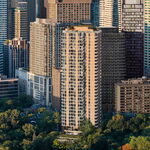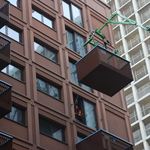Allandale25
Senior Member
^ Cool. Refurbished in Thunder Bay or somewhere else?
Should be by CAD in Lachine, Quebec. Actually, as I type this, I'm on of their cars right now:^ Cool. Refurbished in Thunder Bay or somewhere else?
Commuter rail operators across the country have released their 2019 schedules, which means it’s time for my annual summary of Commuter Rail service.
As with every year I have made these summaries, there has been expansion of rail service in Ontario, and absolutely no improvement anywhere else in the country. The only progress outside of Ontario is that the Réseau de Transport de Montréal (RTM) has now branded their commuter rail services as “Exo”, which means that for the second year in a row, Montréal commuter rail lines received sharp-looking rebranded schedules with the same train times as always.
Frequency
In September, the GO Transit Lakeshore East line reached a milestone with a weekday midday service increase to every 15 minutes. This frequency is notable because it was the benchmark advertised to represent “Regional Express Rail”, the brand name for GO Transit’s aggressive service expansion plan. GO widely publicized the increase in service, with claims such as “every 15 minutes or better, dawn to dusk”, even though the service only exists during the midday off-peak period (roughly 9 AM to 3 PM), meaning that most stations are still only served every 30 minutes during the peak periods.
At the same time, a new hourly service was added to the Lakeshore West line between Oakville and Toronto on weekdays midday, in addition to the existing half-hourly service. The end result is a bizarre service pattern with trains being alternating between 15-minute headways and 30-minute headways. I’m assuming the plan is to add more trains in the future to provide a consistent 15-minute midday service.
This year’s incremental expansion in peak commuting trips came in the form of one new morning peak period trip from Malton to Toronto on the Kitchener line. It is notable that this trip starts at Malton rather than one stop further at Bramalea, given that the latter is the busiest station on the line. My guess is that the trip falls short of that major ridership source because the south platform at Bramalea is still closed for construction and therefore the train would have nowhere to sit out of the way of GO and CN traffic passing through.
Due to railway construction in Toronto and Montréal, three lines have had service temporarily reduced in 2018.
The RTM’s Deux Montagnes line (Exo 6) and Mascouche line (Exo 5) have had service reduced to accommodate construction on the new Réseau Express Métropolitain metro line at Gare Centrale. On the Deux Montagnes Line, weekday service has dropped from 25 trains per day to 22 Monday to Thursday, and only 18 trains per day on Fridays. The service reduction was spread out through the peak commuting periods so it doesn’t show up in my table due to rounding. The Mascouche line maintained its 8 weekday trains Monday to Thursday, but drops to 7 trains on Fridays.
GO Transit’s Stouffville line has had weekday late-evening service cancelled to facilitate construction underway to widen the railway between Kennedy and Milliken stations in Toronto. Rather than hourly train service, there is now bus service every 30 minutes to the stations outside Toronto, but no service to the stations within Toronto.
Service Extensions
Many of the big news items of 2018 have actually been service extensions, many of which aren’t captured in my table because of the way it’s written. As of the January 2019 schedules, several trips on the Kitchener Line were extended to destinations further from Toronto, but the big news item was that starting 7 January 2019 one daily commuter roundtrip on the Lakeshore West line will be extended beyond Hamilton to Niagara Falls.
Niagara Falls has already had summer weekend GO service for several years, but this represents the first GO train service to operate year-round to Niagara, and the first commuter rail service to Niagara since VIA Rail canceled its commuter trips in 2012. Indeed the newly-elected Provincial government was keen to highlight this fact, going as far as to hold a news conference just to announce that one existing train trip would be extended two stops further. The problem is that this service is purely a political tool – it is completely useless for transportation.
The new populist Conservative government wants to seem like it is improving train service to Niagara like it promised during the election, but doesn’t want to spend any money on the infrastructure which would allow that train service to be at all useful. In the press conference, Transportation Minister Jeff Yurek proclaimed that the new “government of the people” was delivering Niagara GO Train service “four years ahead of schedule”. Of course the reason that the previous government’s schedule did not include this service in 2019 is that the tracks have not yet been built to support it. There is no connection from Hamilton West Harbour station to the railway toward Niagara, which means that the new Niagara train needs to drive past Hamilton West Harbour station and back in, which adds a lot of time to the trip. The railway has also not yet been upgraded beyond Hamilton, which means that the train plods along at less than 50 km/h through Hamilton’s built-up area. The result is that the new train trip is actually slower than the bus trip it replaces, a bus trip which actually still exists. My guess is that the train was a last-minute addition by politicians after the January bus schedules had already been written.
It is doubtful the new train service will attract enough new revenue to offset the cost of the press conference announcing it, let alone the operating cost of the train, but clearly the new provincial government would rather flush a small amount of money down the toilet in the name of railways than to spend a larger amount on meaningful investments in rail infrastructure. And yet, in classic populist fashion, minister Yurek concludes: “We make every decision with the customer – the Ontario taxpayer – in mind. Our Government for the People looks forward to continuing to provide better transportation across the province”.
How accurate are the ridership numbers? Are they the same as last year's?Here's my annual commuter rail summary in case anyone's interested. Not quite as celebratory as last year's post.
https://ontariotrafficman.wordpress.com/2018/12/30/canadian-commuter-rail-summary-2018/
Improvements highlighted in green, reductions highlighted in red.
View attachment 169120
Niagara Falls has already had summer weekend GO service for several years, but this represents the first GO train service to operate year-round to Niagara, and the first commuter rail service to Niagara since VIA Rail canceled its commuter trips in 2012. Indeed the newly-elected Provincial government was keen to highlight this fact, going as far as to hold a news conference just to announce that one existing train trip would be extended two stops further. The problem is that this service is purely a political tool – it is completely useless for transportation.
The new populist Conservative government wants to seem like it is improving train service to Niagara like it promised during the election, but doesn’t want to spend any money on the infrastructure which would allow that train service to be at all useful. In the press conference, Transportation Minister Jeff Yurek proclaimed that the new “government of the people” was delivering Niagara GO Train service “four years ahead of schedule”. Of course the reason that the previous government’s schedule did not include this service in 2019 is that the tracks have not yet been built to support it. There is no connection from Hamilton West Harbour station to the railway toward Niagara, which means that the new Niagara train needs to drive past Hamilton West Harbour station and back in, which adds a lot of time to the trip. The railway has also not yet been upgraded beyond Hamilton, which means that the train plods along at less than 50 km/h through Hamilton’s built-up area. The result is that the new train trip is actually slower than the bus trip it replaces, a bus trip which actually still exists. My guess is that the train was a last-minute addition by politicians after the January bus schedules had already been written.
It is doubtful the new train service will attract enough new revenue to offset the cost of the press conference announcing it, let alone the operating cost of the train, but clearly the new provincial government would rather flush a small amount of money down the toilet in the name of railways than to spend a larger amount on meaningful investments in rail infrastructure. And yet, in classic populist fashion, minister Yurek concludes: “We make every decision with the customer – the Ontario taxpayer – in mind. Our Government for the People looks forward to continuing to provide better transportation across the province”.
How accurate are the ridership numbers? Are they the same as last year's?
Thanks a bunch. It honestly sucks that Metrolinx isn't as keen as the TTC on releasing ridership numbers. Hopefully we get an update soon fro not only the GO lines, but the TTC lines and GO Bus lines as well.The ridership is getting a bit out of date, I considered hiding the column altogether. I haven't been able to find up to date data for GO lines for a while now, but I recently discovered that RTM includes the ridership on their route description pages. (Though I noticed they have completely the wrong route length for the Vaudreuil-Hudson line, probably including the now-abandoned tracks to Rigaud). West Coast Express ridership is actually down by 1000 passengers per day compared to two years ago because of increased competition from the new SkyTrain Evergreen extension.
Here's the chart again, this time showing the years of the ridership counts:
View attachment 169121
Here's the chart again, this time showing the years of the ridership counts:
I thought I'd be the only one reading them. I gave up some twenty posts in, IIRC, there were 80 or so replies, which is extraordinarily high for what must have been a bit abstract to most.The comments on that blog are a mess lol
This is amazing, great job! Definitely confusing why Ontario's ridership numbers are so out of date, not to mention missing lots of stuff (e.g station usage, GO bus ridership). I guess QP doesn't want the opposition or media questioning things, but still people want to know numbers.
The ridership is getting a bit out of date, I considered hiding the column altogether. I haven't been able to find up to date data for GO lines for a while now, but I recently discovered that RTM includes the ridership on their route description pages. (Though I noticed they have completely the wrong route length for the Vaudreuil-Hudson line, probably including the now-abandoned tracks to Rigaud). West Coast Express ridership is actually down by 1000 passengers per day compared to 2016 because of increased competition from the new SkyTrain Evergreen extension.
Here's the chart again, this time showing the years of the ridership counts:
View attachment 169122
The 25 from KW only ends at Square One without any connections to the train line, so the 21 would still be required, unless some agreement is made to take the 25 straight to Union.I can only imagine how much Milton's riderhip stagnates due to the lack of trains off-peak. The buses are pretty convenient, but people would be attracted to the train more. Although I suppose they'd have to maintain the bus connection from Union to Square One? Or would they? I guess it's just speculation at this point as there's no off-peak trains on Milton on the horizon.
Thanks a bunch. It honestly sucks that Metrolinx isn't as keen as the TTC on releasing ridership numbers. Hopefully we get an update soon fro not only the GO lines, but the TTC lines and GO Bus lines as well.
This is amazing, great job! Definitely confusing why Ontario's ridership numbers are so out of date, not to mention missing lots of stuff (e.g station usage, GO bus ridership). I guess QP doesn't want the opposition or media questioning things, but still people want to know numbers.
Yeah, it can be FOIed.Can't the ridership be FOIed?
Great post. Do the highlighted cells indicate changes from the previous year?




